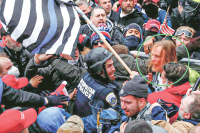A grim look at Appalachia
Authors often dig into their childhood to mine for the coal and diamonds of their books. Sometimes they use the picks and shovels of fiction; Charles Dickens, Charlotte Bronte, and Thomas Wolfe come most famously to mind as writers who frequently turned to the terrors and triumphs of their adolescence and early life to make their books. In our own day, Pat Conroy in The Great Santini, Maya Angelou’s In I Know Why The Caged Bird Sings, and Sandra Cisneros in The House On Mango Street all gained early fame from novels based on a difficult childhood.
In the last 50 years, memoirs have become a popular means of exploring childhood and family relationships. These accounts nearly always focus on the traumatic events and dysfunctional family life. Happy childhoods doubtless produce fewer sales, except in the case of humorous books like Shirley Jackson’s splendid Raising Demons. Here we have only to look at the best-seller lists of the last 20 years to come up with a few examples: the ironically titled A Childhood by Harry Crews; Frank McCourt’s Angela’s Ashes, the story of an Irish childhood awash in drink and poverty; Dave Pelzer’s A Child Called It; Augusten Burroughs’ Running With Scissors; Kaylie Jones’s Lies My Mother Never Told Me; and many more.
In Moonshiner’s Daughter (ISBN 978-0-578-05420-9, $14.95), Mary Judith Messer tells the tale of her own harsh childhood and adolescence in Haywood County. Growing up in the 1940s and 1950s, a time before the War on Poverty did much to ease the suffering of the Appalachian poor, a time, too, when Alcoholics Anonymous had not yet made deep inroads into a culture of poverty whose primary form of entertainment often turned around a jug and a still, Messer faced adversity at nearly every level of her life.
First, there was the hardscrabble poverty in which she lived. Often she, her sisters, and her brother lacked even the rudiments of life: food, shoes, heat in the winter. Worse, both her mother and father, themselves products of a harsh youth, were, by any standard, terrible parents. They may have loved each other, and frequently they showed love to their children, but they also viciously beat them, terrorized them with threats, often cheated on each other in their marriage, and made costly juvenile judgments in terms of how they lived their lives.
It was not poverty, however, which destroyed their lives. Many families here in the mountains and elsewhere rise above straitened circumstances. No, it was liquor that ruled Messer‘s parents and destroyed any possibility for order and discipline in their lives. Like other Appalachian men before him, Terry Lee Long, Messer’s father, kept a still in the woods and sold moonshine to make some cash. Unfortunately, he also drank up any profit to be made from the still. In nearly every scene in which Long appears in Moonshiner’s Daughter, he is drunk, and rarely, it seemed, was he a happy or even a contented drunk. Liquor turned Terry Long mean as one of the many copperheads living on their Fine’s Creek farm, and he took his meanness out on his family, beating his wife unconscious several times and whipping the children simply out of cussedness.
Long was sent to prison on several occasions for making illegal whiskey, but his children found no respite in his absence. In what began as a rape, two neighbor boys, and then a grown man, have sexual relations with Messer’s older sister, 13-year-old Cheryl. With the father in the federal clink, the family had even less to eat and could not chop enough wood to stay warm. At one point, having taken firewood from the walls of their old barn, the children under orders of their mother then burned the barn to conceal the act from their father (For some reason, they only removed a horse from the barn; they incinerated the chickens and all the equine tack along with the barn).
Related Items
Messer was eventually rescued from this ordeal through the efforts of the Queen family, who hire her as a mother’s helper at the Queen ranch in Maggie Valley. She traveled with the family to Washington and later went to New York City, where she lived with her older sister. Life there remained a struggle; both young women had trouble holding jobs, and Messer was raped by a photographer who demanded sex from her in exchange for some pictures he had made of Messer’s nephew.
Though a powerful statement, Moonshiner’s Daughter does contain some flaws. There are a number of printing and unintentional errors of grammar in the book. Even more bothersome, the book leaves readers with a number of unanswered questions. Messer never explains why, on the front cover of the book and in another picture, the faces of her siblings as children are whited out. Nor does she tell us the ultimate fate of her younger siblings. Did they too escape the sad history of their family? And why, after the photographer rapes her, does she then send her sister back to pick up the photographs? She herself tells us that the photos even today remind her of the rape. This rape also left Messer pregnant. When a male benefactor helps her find a place in a Catholic convent catering to unwed mothers while she awaits the birth of the child, Brenda Lee, whom she then gave up for adoption, Messer follows the practices of the Catholic Church, taking communion and going to confession, yet she never explains why she felt compelled to do so. It seems unlikely that only Catholic girls were assisted in this fashion, but Moonshiner’s Daughter doesn’t tell us if that this was indeed the case.
Despite these faults, Moonshiner’s Daughter gives us a slice of Appalachia from a time now vanished from these mountains. Drug abuse and alcohol continue to plague families here as elsewhere, but the grinding farm life and the moonshining have largely given way to the more general ills of modern life. Messer’s voice — direct, simple, conversational — lends a force to her writing that should attract many readers.
Moonshiner’s Daughter by Mary Judith Messer. Doing Well Now Publishers. 218 pagegs









